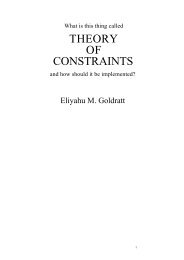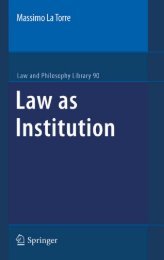Making of a German Constitution : a Slow Revolution
Making of a German Constitution : a Slow Revolution
Making of a German Constitution : a Slow Revolution
Create successful ePaper yourself
Turn your PDF publications into a flip-book with our unique Google optimized e-Paper software.
102 • The <strong>Making</strong> <strong>of</strong> a <strong>German</strong> <strong>Constitution</strong>Cicero’s legal defence <strong>of</strong> the actor, Q. Roscius, in a case with C. Fannius Chareainvolving money claims. The article represented an attempt to recover legal procedurefrom the era <strong>of</strong> the Roman Republic. Unterholzner was interested, specifically,to understand in what type <strong>of</strong> civil matters the ‘Collegium von Geschworenen’(collegium <strong>of</strong> jurors) served. 15 Savigny’s ‘Beytrag zur Geschichte der RömischenTestamente’ was marked by his concern to recover the laws governing last wills andtestaments from the Republic, which had been changed by the corpus iuris civilis.During the ‘time <strong>of</strong> the Republic’, there had been ‘two different forms <strong>of</strong> written privatewills, both fully valid, so that one had a choice (Wahl) between both’. 16 This liberty<strong>of</strong> choice between a ‘civil will with Mancipation’ and ‘the praetorian will withseven witnesses and seven seals,’ was no longer possible under the ‘Justinian law,’and choice was lost when only the form <strong>of</strong> Manicipation was recognized. 17 In thesecond volume, Unterholzner <strong>of</strong>fered an article on the Twelve Tables. 18 Göschen’s‘Einige Bemerkungen in Beziehung auf das ältere Recht der Freylassungen bey denRömern’ (1817) was interested to delineate the ancient law covering release fromcustody on bail. 19In 1817, Savigny reported Barthold Niebuhr’s discovery <strong>of</strong> the Institutes <strong>of</strong> Gaiusin Verona, and published a fragment <strong>of</strong> the letter from Niebuhr regarding his find. 20He <strong>of</strong>fered thankful praise to the man, who had done ‘brilliant service for the historicalbasis <strong>of</strong> our science’. 21 In the same volume, Niebuhr also <strong>of</strong>fered an articleabout his discovery. 22 In, yet, another article in 1817, he published the full text <strong>of</strong> hisoriginal letter to Savigny. 23 The importance <strong>of</strong> the discovery <strong>of</strong> the Institutes <strong>of</strong> Gaiuscannot be emphasized enough. It came close to doubling what was then known aboutRoman law. In contrast to the sources <strong>of</strong> Roman law prior to this discovery, what theInstitutes <strong>of</strong> Gaius <strong>of</strong>fered was history. For the first time, it was actually possible forscholars to research the constitutional and legal history from the era <strong>of</strong> the Republic.In addition, it was a source <strong>of</strong> knowledge on key areas <strong>of</strong> Roman public and privatelaw, including the legal status <strong>of</strong> persons, property rights and contracts. Finally, itwas an invaluable source <strong>of</strong> information about Roman legal procedures, and therewas very little information on this subject prior to Niebuhr’s find. 24 The discovery <strong>of</strong>the Institutes <strong>of</strong> Gaius ensured that the historical approach to Roman law, on a socialscientific basis, would continue to flourish in <strong>German</strong> universities.In fact, it was the historian, Niebuhr, who <strong>of</strong>fered the suitable, social scientificinterpretation <strong>of</strong> Roman political and constitutional history that would support constitutionaltransformation. As he wrote in the Preface to the 1826 edition <strong>of</strong> his RömischeGeschichte (1811), he had been languishing in Rome and suffering fromwriter’s block, until ‘the point on which an inquiry hinged would come forward intoclear light while I was conversing with Savigny’. 25 The Preface also <strong>of</strong>fers an importantwindow into the social and political world that Niebuhr’s Römische Geschichtespoke to. ‘The history <strong>of</strong> Rome’, he opened, ‘was treated, during the first two centuriesafter the revival <strong>of</strong> letters, with the same prostration <strong>of</strong> understanding and judgementto the written letter that had been handed down, and with the same fearfulness




